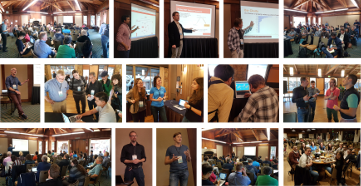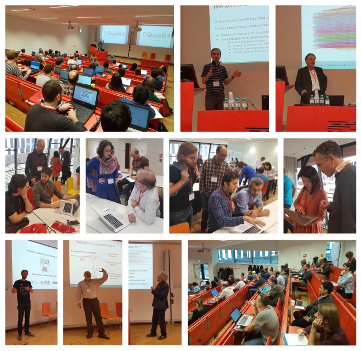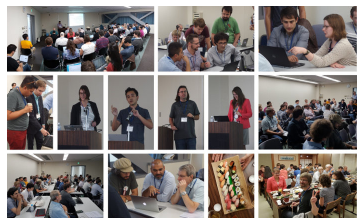Visualizations and User Interfaces for Ontologies and Linked Data
Workshop co-located with ISWC 2015, October 11, 2015, Bethlehem, Pennsylvania, USA

Motivation and Objectives
'A picture is worth a thousand words', we often say, yet many areas are in demand of sophisticated visualization techniques, and the Semantic Web is not an exception. The size and complexity of ontologies and Linked Data in the Semantic Web constantly grow and the diverse backgrounds of the users and application areas multiply at the same time. Providing users with visual representations and intuitive user interfaces can significantly aid the understanding of the domains and knowledge represented by ontologies and Linked Data. There is no one size fits all solution but different use cases demand different visualization and interaction techniques. Ultimately, providing better user interfaces and visual representations will foster user engagement and likely lead to higher quality results in different applications employing ontologies and to the proliferation of Linked Data usage.
User interfaces are essential to easily provide access to the increasing diversity of knowledge modeled in ontologies. As ontologies grow in size and complexity, the demand for comprehensive visualization and sophisticated interaction also rises. In particular, user interfaces are an integral part of ontology engineering, to help bridge the gap between domain experts and ontology engineers. Ontology visualization is not a new topic and a number of approaches have become available in recent years, with some being already well-established, particularly in the field of ontology modeling. In other areas of ontology engineering, such as ontology alignment and debugging, although several tools have recently been developed, few provide a graphical user interface, not to mention navigational aids or comprehensive visualization techniques.
While ontology users usually possess domain and/or knowledge representation expertise, this is not necessarily the case with potential Linked Data consumers who can come from very different backgrounds and have varying levels of expertise. Currently, the main Linked Data consumers are technology experienced users, one of the reasons being the lack of appropriate user interfaces and visualizations to support other user groups. Visual approaches are needed to assist various kinds of users, who pursue diverse goals and pose individual requirements. In the presence of a huge network of interconnected resources, one of the challenges faced by the Linked Data community is the visualization of the multidimensional datasets to provide for efficient overview, exploration and querying tasks, to mention just a few. With the focus shifting from a Web of Documents to a Web of Data, changes in the interaction paradigms are in demand as well. Novel approaches also need to take into consideration the technological challenges and opportunities given by new interaction contexts, ranging from mobile and touch interaction to visualizations on large displays, and encompassing highly responsive web applications.
Program
The workshop takes place at Lehigh University's Rauch Business Center (621 Taylor St., Bethlehem, PA 18015) in room RBC 271. The room is on the second floor, right next to the cafeteria. Be prepared the room can be quite cold due to air conditioning.
9:00 - 9:15 Opening
9:15 - 10:30 Session I: Visualizing Semantic Data
9:15 - 9:24 Discovering Issues in Datasets Using LODSight Visual Summaries
(Marek Dudáš and Vojtech Svátek)
9:24 - 9:42 Visual Exploration of Formal Requirements for Data Science Demand Analysis
(Aba-Sah Dadzie and John Domingue)
9:42 - 9:54 Cognitive-based Visualization of Semantically Structured Cultural Heritage Data
(Kalliopi Kontiza, Antonis Bikakis and Rob Miller)
9:54 - 10:06 Visualizing the Evolution of Ontologies: A Dynamic Graph Perspective
(Michael Burch and Steffen Lohmann)
until 10:30 Discussion
10:30-11:00 Coffee Break
11:00 - 12:30 Session II: Ontology Alignment
11:05 - 11:23 ProvenanceMatrix: A Visualization Tool for Multi-Taxonomy Alignments
(Tuan Dang, Nico Franz, Bertram Ludaescher and Angus Forbes)
11:23 - 11:41 Visual Analytics for Ontology Matching Using Multi-Linked Views
(Jillian Aurisano, Amruta Nanavaty and Isabel F. Cruz)
11:41 - 11:59 Interactive Visualization of Large Ontology Matching Results
(Yiting Li, Cosmin Stroe and Isabel F. Cruz)
until 12:30 Discussion
12:30 - 14:00 Lunch at Lehigh's University Center (UC)
14:00 - 15:15 Session III: Demo Session
Presenters:
- Isabel Cruz
- Aba-Sah Dadzie
- Ahmet Soylu
- Ali Hasnain
- Miguel Ceriani
- Steffen Lohmann
- Marek Dudáš
- Elmar Kiesling
- Karlis Cerans
15:15 - 15:45 Coffee Break
15:45 - 17:15 Session IV: Querying and Semantic Annotation
15:45 - 16:03 FedViz: A Visual Interface for SPARQL Queries Formulation and Execution
(Syeda Sana E Zainab, Ali Hasnain, Muhammad Saleem, Qaiser Mehmood, Syeda Durr E Zehra and Stefan Decker)
16:03 - 16:12 SPARQL Playground: A Block Programming Tool to Experiment with SPARQL
(Paolo Bottoni and Miguel Ceriani)
16:12 - 16:21 OptiqueVQS: Ontology-Based Visual Querying
(Ahmet Soylu, Evgeny Kharlamov, Dmitriy Zheleznyakov, Ernesto Jimenez-Ruiz, Martin Giese and Ian Horrocks)
16:21 - 16:30 Representing and Visualizing Text as Ontologies: A Case from the Patent Domain
(Stamatia Dasiopoulou, Steffen Lohmann and Leo Wanner)
16:30 - 16:39 An Autocomplete Input Box for Semantic Annotation on the Web
(Tuan-Dat Trinh, Peter Wetz, Ba-Lam Do, Peb Ruswono Aryan, Elmar Kiesling and A Min Tjoa)
until 17:15 Discussion
17:15 - 17:30 Closing
19:00 - Social Dinner at MacGrady's (our table is in a separate room in the back area)
Impressions
About 30 researchers and practitioners took part in the full-day event consisting of talks, discussions, and tool demonstrations. Here are some impressions from the workshop:
Proceedings
The workshop proceedings are published as CEUR-WS volume 1456.
V. Ivanova, P. Lambrix, S. Lohmann, C. Pesquita: Proceedings of the International Workshop on Visualizations and User Interfaces for Ontologies and Linked Data (VOILA '15), Bethlehem, Pennsylvania, USA. CEUR Workshop Proceedings, vol. 1456, CEUR-WS.org, 2015.
Topics of Interest
Topics of interest include (but are not limited to):
- Visualizations for (large and complex) ontologies;
- Visualization of ontology design patterns;
- Linked Data visualizations and user interfaces;
- Visualizations and user interfaces for ontology engineering (ontology development, alignment, debugging, etc.);
- Requirements analysis for ontology and Linked Data visualizations;
- Case studies of applying visualizations in ontology engineering and Linked Data consumption;
- Context-aware visualization and interaction techniques;
- Applications of novel interaction techniques (e.g., touch and gesture interaction);
- User interfaces for collaborative ontology development;
- Ontology visualizations for large and high-resolution displays;
- Mobile user interfaces for ontology engineering and Linked Data exploration;
- User interfaces assisting people with disabilities;
- Visual exploration and querying of Linked Data.
Submission Guidelines
Paper submission and reviewing for this workshop will be electronic via EasyChair. The papers should be written in English, following the Springer LNCS format, and be submitted in PDF on or before July 10, 2015.
The following types of contributions are welcome:
- Full research papers (8-12 pages);
- Experience papers (8-12 pages);
- Position papers (6-8 pages);
- Short research papers (4-6 pages);
- System papers (4-6 pages).
Accepted papers will be published as a volume in the CEUR Workshop Proceedings series.
Note that workshop attendees cannot register for the workshop only, but need to register for the main conference, as well.
Organizers
Patrick Lambrix, Linköping University, Sweden
Steffen Lohmann, University of Stuttgart, Germany
Catia Pesquita, University of Lisbon, Portugal
Programme Committee
Marius Brade, TU Dresden
Isabel F. Cruz, University of Illinois at Chicago
Aba-Sah Dadzie, KMi, The Open University
Aidan Delaney, University of Brighton
Michael Granitzer, University of Passau
Anika Gross, University of Leipzig
Willem Robert van Hage, SynerScope B.V.
Eero Hyvönen, Aalto University & University of Helsinki
Tomi Kauppinen, Aalto University School of Science
Suvodeep Mazumdar, University of Sheffield
Enrico Motta, KMi, The Open University
Paul Mulholland, KMi, The Open University
Stefan Negru, MSD IT Global Innovation Center
Silvio Peroni, University of Bologna & CNR-ISTC
Emmanuel Pietriga, INRIA Saclay
Mariano Rico, Technical University of Madrid
Harald Sack, HPI, University of Potsdam
Gem Stapleton, University of Brighton
Vojtěch Svátek, University of Economics, Prague
Important Dates
- Submission:
July 10, 2015 - Notification:
August 5, 2015 - Camera-ready:
August 24, 2015 - Workshop:
October 11, 2015



















